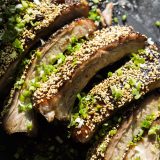For a fresh take on sticky ribs, we took inspiration from an old, yet ever-evolving Hawaiian dish: the plate lunch.
Sold in supermarkets, food trucks, drive-ins and beachside shacks, the plate lunch is ubiquitous in Hawaii. The meal is a holdover from the heyday of Hawaiian sugar and pineapple farming, when lunch wagons provided a cheap, filling lunch to plantation workers. Served on a compartmentalized plate, it supplanted the bento boxes of many immigrant workers.
Plate lunch has changed since the 1880s—when it first came about—but it's anchored by two scoops of rice and a mayo-laden macaroni salad. The protein is variable. It might be huli-huli chicken, seaweed-flecked poke, chicken katsu or glazed pork ribs.
Those ribs are a simple affair (marinated, baked and glazed), but the tender meat and sticky glaze make them highly addictive. Their secret lies in hoisin sauce, the sweet, dark condiment commonly served alongside spring rolls, basted onto barbecued pork or squirted into pho.
Made from fermented soy beans, garlic, spice and sweetener, hoisin packs deep, resonant flavor. But it doesn't have much in the way of brightness. For our hoisin-glazed ribs, we wanted to change that.
So we processed the hoisin with cilantro (stems and all), garlic, fresh ginger and a hit of five-spice powder. Honey enhanced the sweetness and an unconventional shot of Korean gochujang, a fiery paste of fermented chilies and seasonings, added heat. (If you can't find gochujang, you can substitute an equal amount of Sriracha.)
That gave us a bold marinade for baby back ribs, which we let sit overnight to absorb the flavors. A slow roast in a foil packet rendered the meat fork tender, and the juices that accumulated in the foil made a potent glaze when mixed with leftover marinade.
Slathered on the ribs, the glaze became crispy and browned when returned to the oven. And for a final shot of brightness to these sweet-spicy-salty ribs, we sprinkled them with sesame seeds and scallions.




